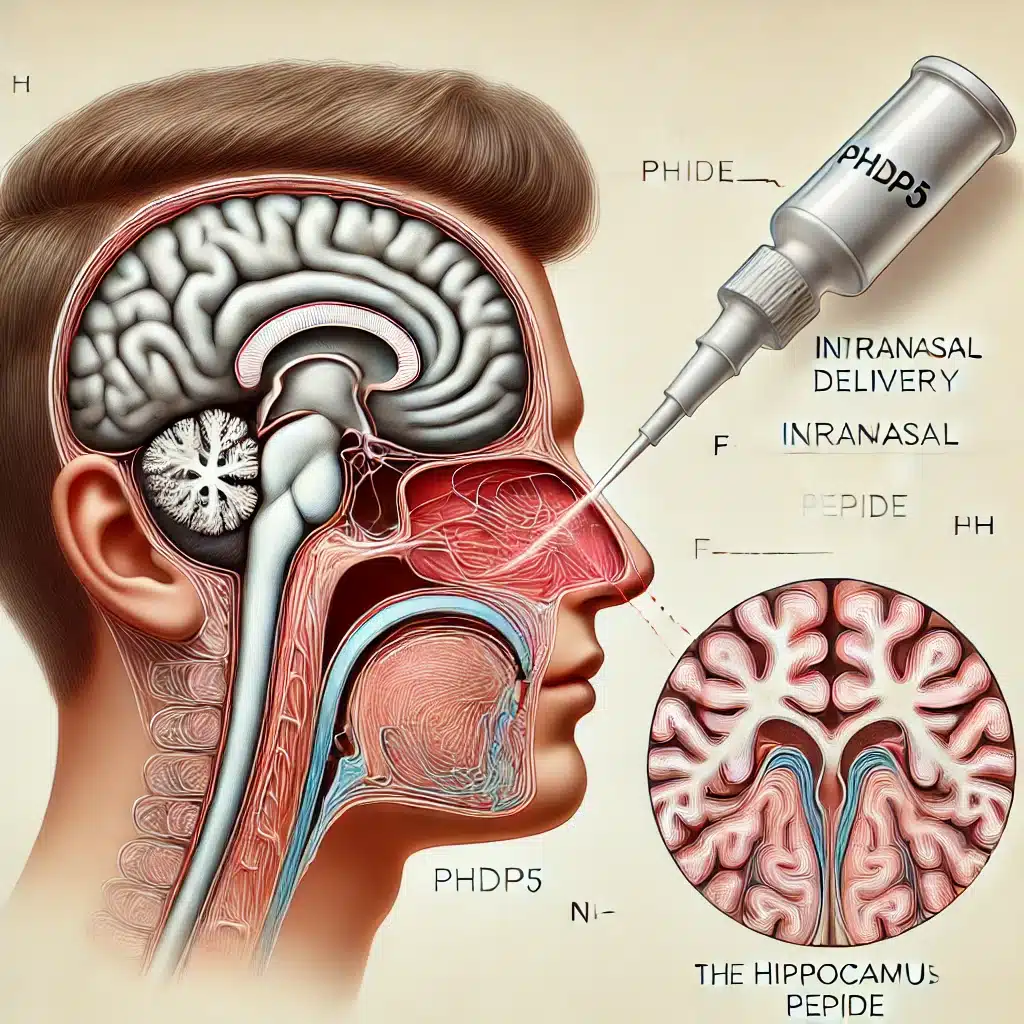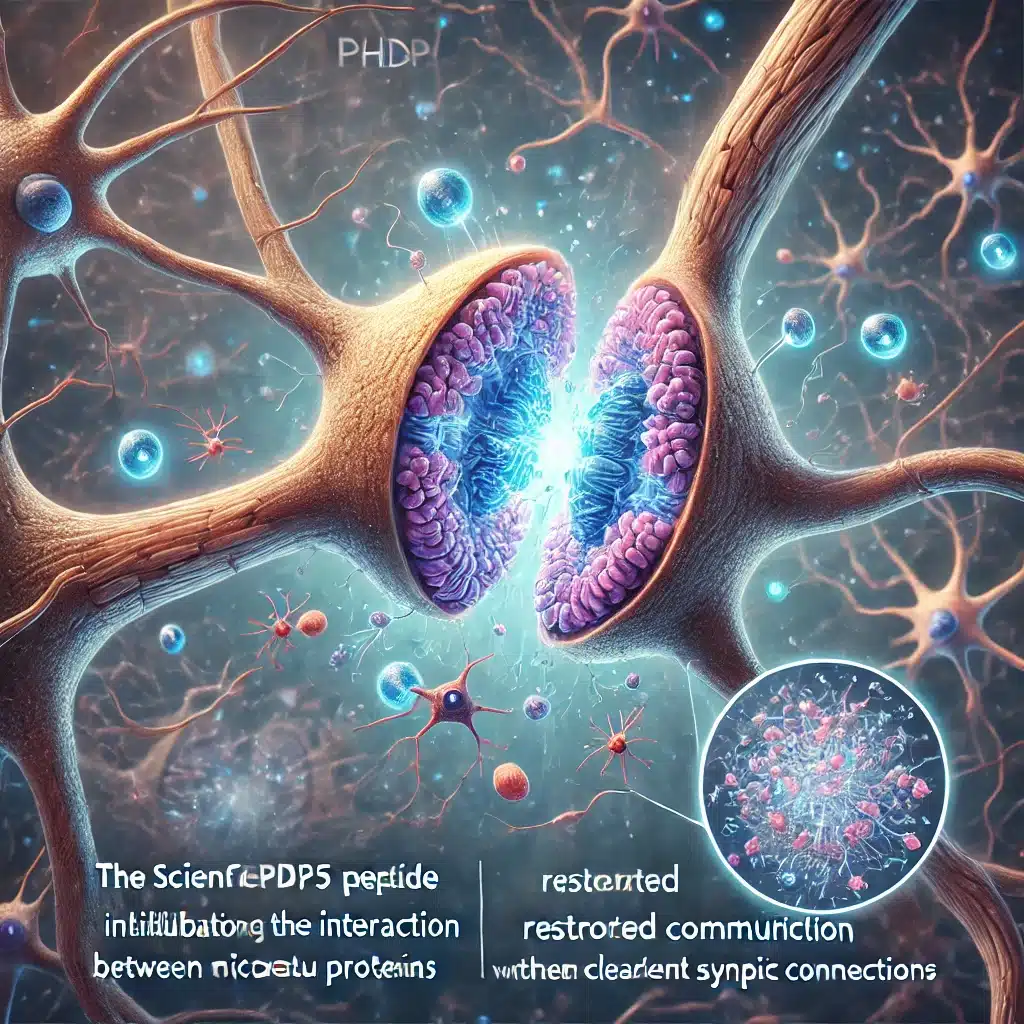TLDR: Researchers demonstrated that intranasal administration of the peptide FITC-PHDP5-CPP reverses early cognitive impairment in Alzheimer’s disease (AD) model mice, showing potential as a treatment for AD-associated cognitive decline.
Highlights:
- PHDP5, derived from the pleckstrin homology domain of dynamin 1, inhibits the interaction between dynamin and microtubules, rescuing synaptic dysfunction caused by tau accumulation.
- The peptide FITC-PHDP5-CPP was delivered intranasally to bypass the blood-brain barrier, ensuring delivery to the hippocampus.
- In the Morris water maze test, AD model mice treated with FITC-PHDP5-CPP showed significant improvements in spatial learning and memory, performing close to wild-type control mice.
- The improvements were specific to the PHDP5 peptide; a scrambled version (FITC-SPHDP5-CPP) showed no significant effect.
- PHDP5 is a promising candidate for human Alzheimer’s therapy, potentially improving cognitive function by targeting tau-induced synaptic impairments.
Source: Brain Research (2024)
History of Using Peptides to Reverse Cognitive Impairment
Early Research
1950s-1960s: The exploration of peptides began with the discovery of their role in various physiological processes, including hormone regulation and neurotransmission. Early studies focused on understanding how peptides like insulin and oxytocin function in the body.
Neuroactive Peptides
1970s-1980s: Researchers identified neuroactive peptides, such as enkephalins and endorphins, which are involved in pain regulation and mood enhancement. This period marked the beginning of understanding peptides’ potential in influencing brain function and cognitive processes.
Advances in Research
Peptides & Memory
1990s: Studies began exploring how peptides could influence memory and learning. Researchers discovered that certain peptides, such as vasopressin and oxytocin, play a role in memory formation and retrieval.
Therapeutic Potential
2000s: The focus shifted to developing peptides as therapeutic agents for cognitive impairments. Peptides like noopept and cerebrolysin showed promise in preclinical studies, indicating potential benefits in enhancing memory and cognitive function.
Modern Developments
Targeting Alzheimer’s Disease
2010s: Significant progress was made in targeting Alzheimer’s disease. Researchers identified amyloid-beta and tau proteins as key factors in the disease and began developing peptides to counteract their harmful effects. For instance, peptides like NAP (davunetide) demonstrated neuroprotective properties in preclinical models.
Recent Years: Advances in biotechnology and peptide synthesis have led to more sophisticated peptide-based therapies. Researchers are now designing peptides that can cross the blood-brain barrier and specifically target disease mechanisms in Alzheimer’s and other neurodegenerative diseases.
Major Findings: Peptide Reverses Cognitive Deficits in Alzheimer’s Model (2024)
1. Peptide Effectiveness
Mice with Alzheimer’s-like symptoms showed significant improvements in memory and learning after being treated with the FITC-PHDP5-CPP peptide.
These mice performed almost as well as healthy mice in the Morris water maze test, which is used to measure spatial learning and memory.
2. Specificity of Treatment
Only the specific PHDP5 peptide had the desired effect.
Mice treated with a scrambled version of the peptide (FITC-SPHDP5-CPP) showed no significant improvement, indicating that the positive results were due to the specific action of PHDP5.
3. Delivery to the Brain
The intranasal delivery method was effective in getting the peptide into the brain.
Fluorescent markers showed that the peptide reached the hippocampus, a critical area for memory formation and retention.
4. Synaptic Function Restoration
The PHDP5 peptide successfully blocked the harmful interaction between tau proteins and microtubules, which is responsible for synaptic dysfunction in Alzheimer’s disease.
This led to a restoration of normal brain cell communication.
5. Behavioral Test Results
Treated mice showed a significant reduction in the time it took to find the hidden platform in the water maze over several days of testing.
This improvement in spatial learning and memory was maintained, showing that the peptide had a lasting positive effect.
6. Potential for Treatment
The findings suggest that PHDP5 has strong potential as a treatment for Alzheimer’s disease in humans.
By improving memory and learning in mice with Alzheimer’s-like symptoms, PHDP5 could help alleviate cognitive decline in human patients.
Study Details: Peptide PHDP5 with CPP & FITC to Reverse Alzheimer’s Disease (2024)
Sample
- Subjects: The study used two types of genetically modified mice that mimic Alzheimer’s disease: Tau609 and 3xTg-AD mice.
- Age: Mice were six months old, a stage where cognitive impairments are evident.
Methods
- Peptide: PHDP5, modified with a cell-penetrating peptide (CPP) and a fluorescent marker (FITC), called FITC-PHDP5-CPP.
- Administration Route: Intranasal delivery to bypass the blood-brain barrier and target the hippocampus.
- Morris Water Maze (MWM): Used to assess spatial learning and memory over four days of training, followed by a memory retention test on the fifth day.
- Fluorescence Microscopy: Confirmed the presence of FITC-PHDP5-CPP in the hippocampus post-administration.
Limitations
- Animal Models: The study was conducted on mouse models, which may not fully replicate human Alzheimer’s disease pathology and response to treatment.
- Scrambled Peptide Control: While the scrambled version showed no effect, further testing on different controls and additional models could provide a more comprehensive understanding of PHDP5’s efficacy.
- Duration of Study: The study focused on short-term cognitive improvements. Long-term effects and potential side effects of chronic PHDP5 administration were not assessed.
- Translation to Humans: While promising, results from mouse models require extensive validation through human clinical trials to confirm safety and effectiveness in humans.
What is the PHDP5 Peptide?

PHDP5 is derived from the pleckstrin homology domain of dynamin 1, a protein crucial for endocytosis, a process that allows brain cells to recycle and transmit signals efficiently.
Purpose: Researchers developed PHDP5 to specifically inhibit the harmful interactions between dynamin and microtubules caused by tau protein accumulation in Alzheimer’s disease.
Enhancements: To ensure effective delivery to the brain, PHDP5 was modified by adding a cell-penetrating peptide (CPP) and a fluorescent marker (FITC). This modified peptide is referred to as FITC-PHDP5-CPP.
Intranasal Delivery: This modification allows the peptide to be administered intranasally, bypassing the blood-brain barrier and targeting the hippocampus, a key area for memory and learning.
Mechanisms of Action
Inhibition of Dynamin-Microtubule Interaction
- Normal Function: Dynamin is essential for vesicle endocytosis, which enables neurons to communicate effectively by recycling synaptic vesicles.
- Problem in Alzheimer’s: In Alzheimer’s disease, tau proteins abnormally accumulate and cause excessive assembly of microtubules, sequestering dynamin and impairing vesicle endocytosis.
- PHDP5 Action: PHDP5 inhibits the binding between dynamin and microtubules, preventing tau-induced disruptions. This restores normal synaptic function, improving communication between neurons.
Restoration of Synaptic Function
- Synaptic Transmission: By blocking the adverse effects of tau, PHDP5 helps maintain proper synaptic transmission, which is crucial for cognitive functions such as memory and learning.
- Research Findings: In brain slice models, PHDP5 has been shown to reverse synaptic dysfunctions caused by tau, indicating its potential efficacy in living organisms.
Potential Utility of PHDP5 Peptide in Humans
Targeted Treatment
PHDP5 specifically inhibits the harmful interaction between dynamin and microtubules caused by tau protein accumulation.
This targeted action is crucial for reducing side effects and improving therapeutic outcomes in humans.
Restoration of Synaptic Function
By restoring normal synaptic function, PHDP5 can potentially improve cognitive functions such as memory and learning, which are significantly impaired in Alzheimer’s disease.
Delivery & Administration
Intranasal administration allows PHDP5 to bypass the blood-brain barrier effectively, ensuring that the peptide reaches the brain and targets the hippocampus, a key area involved in memory processing.
Expected Benefits
Memory & Learning: Based on animal studies, PHDP5 has shown significant improvements in memory and learning. If similar results are observed in humans, PHDP5 could help alleviate cognitive decline in Alzheimer’s patients.
Quality of Life: Improved cognitive function could enhance the quality of life for Alzheimer’s patients, allowing them to maintain independence for a longer period.
Slowing Decline: By targeting the underlying mechanisms of synaptic dysfunction, PHDP5 could slow the progression of Alzheimer’s disease, potentially delaying the onset of severe symptoms.
Clinical Development & Trials
- Safety and Efficacy: Human clinical trials are necessary to determine the safety and efficacy of PHDP5 in Alzheimer’s patients. These trials will assess the peptide’s impact on cognitive function, disease progression, and overall patient well-being.
- Effective Dosing: Clinical trials will help establish the optimal dosing regimen for PHDP5, ensuring maximum therapeutic benefits with minimal side effects.
- Chronic Administration: Studies will also investigate the long-term effects of PHDP5, including any potential side effects of chronic administration and the sustainability of cognitive improvements.
Conclusion: PHDP5 Peptide for Alzheimer’s Disease
The PHDP5 peptide shows great promise as a targeted treatment for Alzheimer’s disease by specifically inhibiting the harmful interactions between tau proteins and microtubules, thereby restoring normal synaptic function.
Its successful intranasal delivery ensures effective bypassing of the blood-brain barrier, targeting the hippocampus to improve memory and learning.
Animal studies have demonstrated significant cognitive improvements, suggesting potential benefits for humans.
With further research and clinical trials, PHDP5 could emerge as a powerful therapeutic option, slowing disease progression and enhancing the quality of life for Alzheimer’s patients.
Additionally, its application may extend to other neurodegenerative diseases, highlighting its broader therapeutic potential.
References
- Study: The microtubule-dynamin binding inhibitor peptide PHDP5 rescues spatial learning and memory deficits in Alzheimer’s disease model mice (2024)
- Authors: Chia-Jung Chang et al.








